Sweden
Development challenges as investment and business opportunities: Sweden’s policy and practices
Sweden has long-standing experience of working with and through the private sector with a strong emphasis on private sector development in developing countries. It sees partnering with the private sector as a cross-cutting issue which can help achieve the strategic goals of Swedish development co-operation.
According to the government’s instruction, Sida should, inter alia, complement and leverage other financial resources that contribute to combating poverty and to long-term sustainable development. Sida’s activities with the private sector must be in line with international norms and principles for responsible business and investment. It aims to scale up collaboration with business through guarantees, challenge funds and public-private development partnerships (PPDPs). All Swedish aid channelled through these instruments is untied. The aim is to mobilise additional resources for development and climate issues, including financial, innovation and private sector know-how.
Swedfund is the national development finance institution, operating on behalf of the Swedish government, whose goal is to eliminate poverty by creating sustainable business. Swedfund co-operates with strategic partners, investors and enterprises that are looking to start up or grow their business in emerging markets. Swedfund offers risk capital in the form of equity, loans and funds.
According to the 2015 DAC Survey on Mobilisation (Benn et al., 2016), Sweden mobilised USD 841 million from the private sector through guarantees in 2012-14, of which 44% targeted climate-related projects. Sida was the most active player in this area through its guarantee programme.
Financial flows from Sweden to developing countries
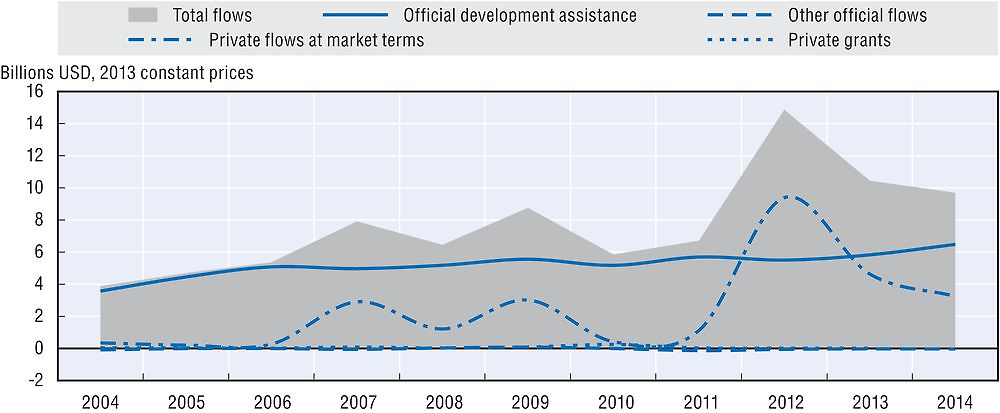
Sweden uses ODA to mobilise other resources for sustainable development
-
Sweden contributes to the mobilisation of domestic resources in developing countries by supporting their tax systems. In 2014, it is estimated that Sweden committed USD 17.4 million of its official development assistance (ODA) to tax-related activities in partner countries.
-
It promotes aid for trade to improve developing countries’ trade performance and integration into the world economy. It committed USD 446.2 million (15.3% of its bilateral allocable ODA) to trade-related activities in 2014, an 8.6% decrease in real terms from 2013. The trend has been fluctuating in recent years.
-
Sweden has committed USD 581.2 million (SEK 4 billion) to the Green Climate Fund (making it the largest per capita donor), which plays a key role in channelling resources to developing countries and catalysing climate finance at the international and national levels. In 2016, Sweden intends to provide a grant of USD 11.5 million (SEK 100 million) to the Least Developed Countries Fund, which addresses urgent and immediate adaptation needs and supports national adaptation planning processes to reduce medium and long-term vulnerability to the impacts of climate change.
Sweden’s official development assistance
In 2015, Sweden provided USD 7.1 billion in net ODA (preliminary data), which represented 1.4% of gross national income (GNI) and a 36.8% increase in real terms from 2014, mostly due to in-donor refugee costs. Sweden is the largest Development Assistance Committee (DAC) provider in terms of ODA as a percentage of GNI, and the sixth largest by volume. Sweden is one of only six DAC members to have met the UN target of 0.7% and it is committed to continue delivering 1% of its GNI to ODA. Sweden’s share of untied ODA (excluding administrative costs and in-donor refugee costs) decreased from 94% in 2013 to 85.8% in 2014, but remains above the DAC average of 80.6% in 2014. The grant element of total ODA was 100% in 2014.
Sweden reported USD 1.1 billion of its in-donor refugee costs as ODA in 2014. These costs represented 17.6% of its total net ODA.
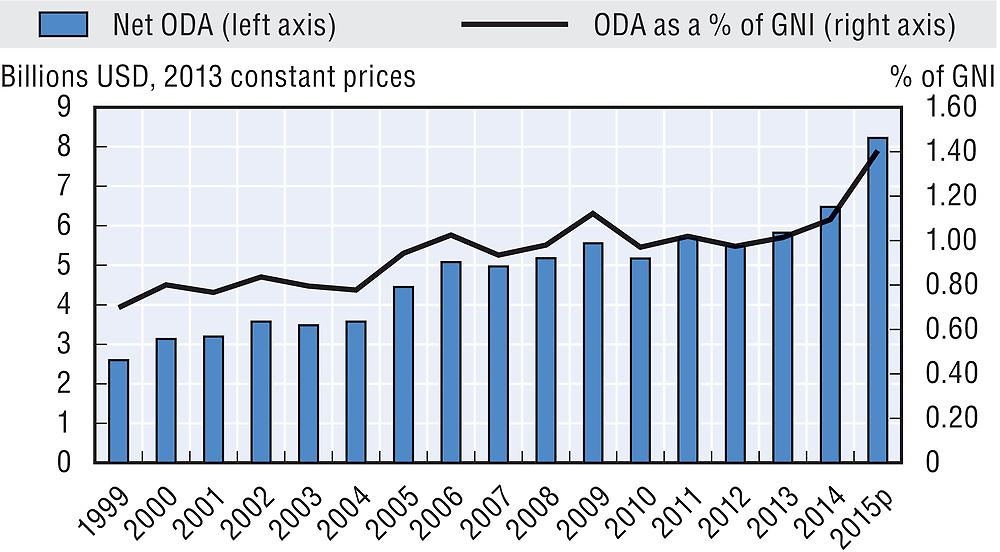
In 2014, 70% of ODA was provided bilaterally. Sweden allocated 30% of total ODA as core contributions to multilateral organisations, compared with the DAC country average of 28.3%. In addition, it channelled 27.6% of its bilateral ODA to specific projects implemented by multilateral organisations (multi-bi/non-core contributions).
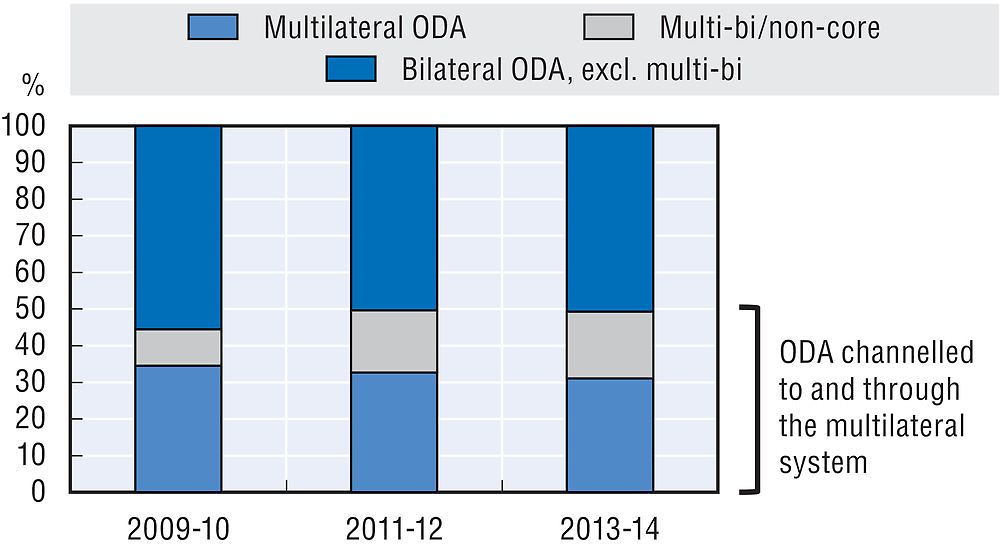
In 2014, 29.2% of bilateral ODA was programmed at partner country level. Sweden’s share of country programmable aid (CPA) was lower than the DAC country average (52.9%). Project-type interventions accounted for 53% of CPA.
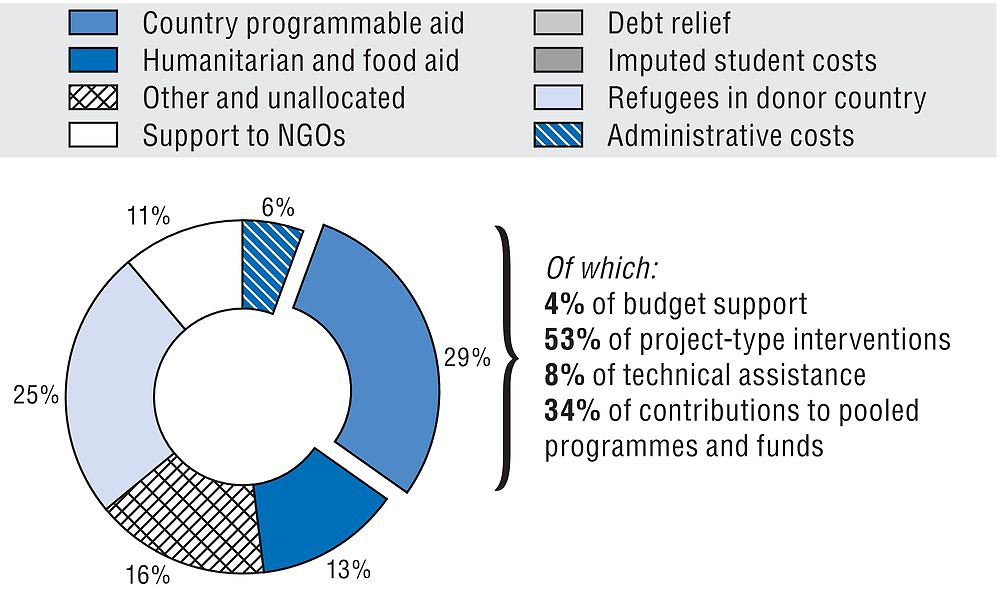
In 2014, USD 1.2 billion of bilateral ODA was channelled to and through civil society organisations (CSOs). Between 2013 and 2014, ODA channelled to and through CSOs increased in volume (+5.8% between 2013 and 2014), but decreased as a share of bilateral aid (from 28.4% to 26.1%). This share was higher than the 2014 DAC country average of 17.4%.
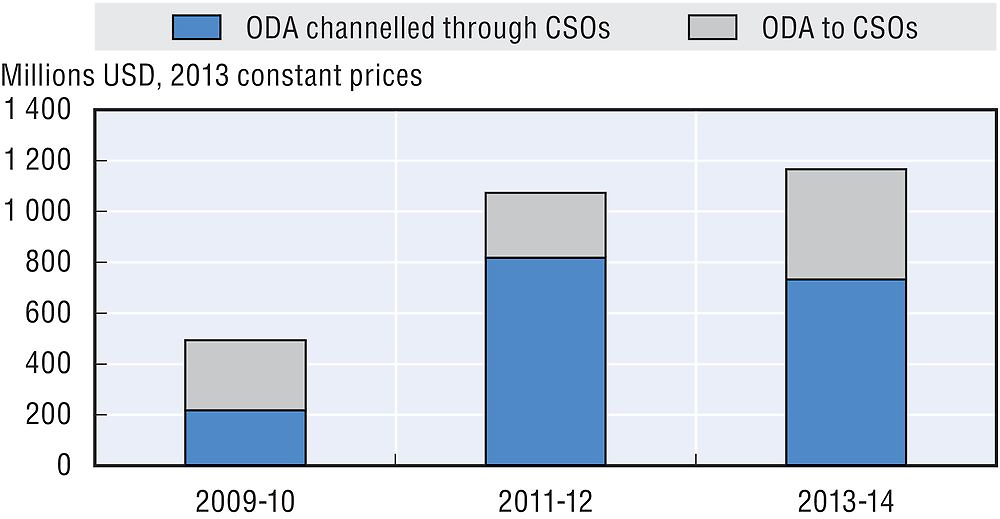
Bilateral ODA was primarily focused on sub-Saharan Africa. In 2014, USD 1 billion was allocated to sub-Saharan Africa, USD 285.3 million to south and central Asia, and USD 253.1 million to the Middle East.
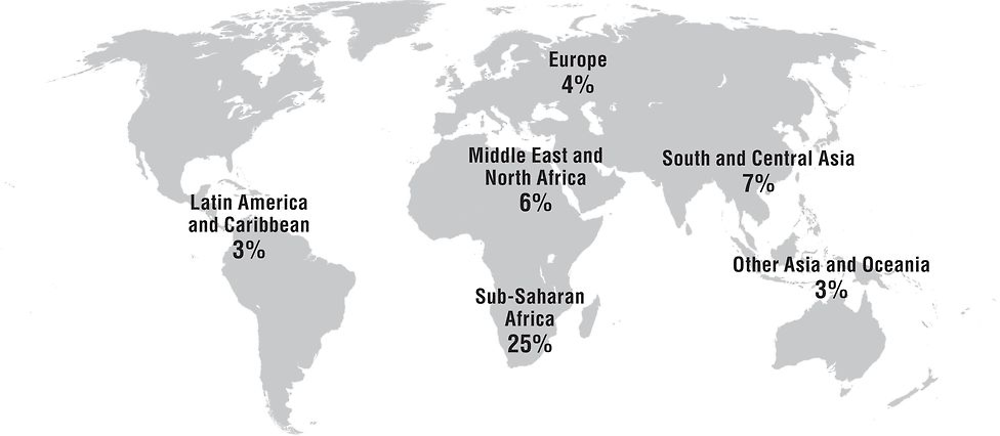
Note: 51% of bilateral ODA allocated was unspecified by region in 2013-14. This share is not represented on the map.
In 2014, 17.1% of bilateral ODA went to Sweden’s top 10 recipients. All of its top 10 recipients are priority partners for Sweden. In 2014, its support to fragile states reached USD 1.1 billion (24.3% of gross bilateral ODA).
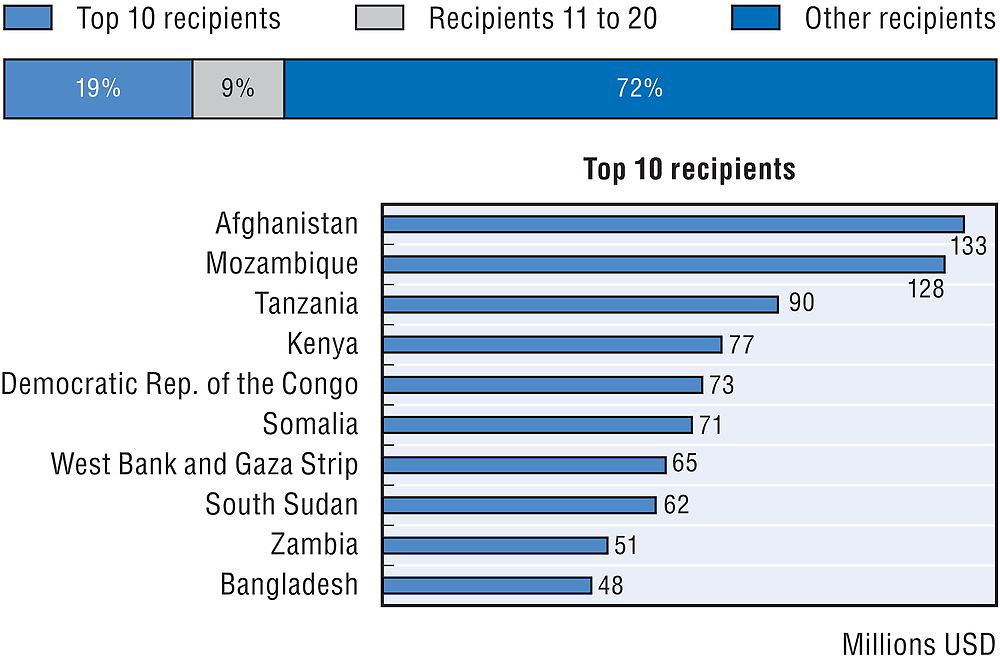
In 2014, 22.5% of bilateral ODA (USD 994.9 million) was allocated to least developed countries (LDCs). This is a decrease from 27.3% allocated to LDCs in 2013, and is lower than the DAC average of 25.6%. LDCs received the highest share of bilateral ODA in 2014, noting that 61.3% was unallocated by income group.
At 0.29% of GNI in 2014, total ODA to LDCs far exceeds the UN target of 0.15% GNI.
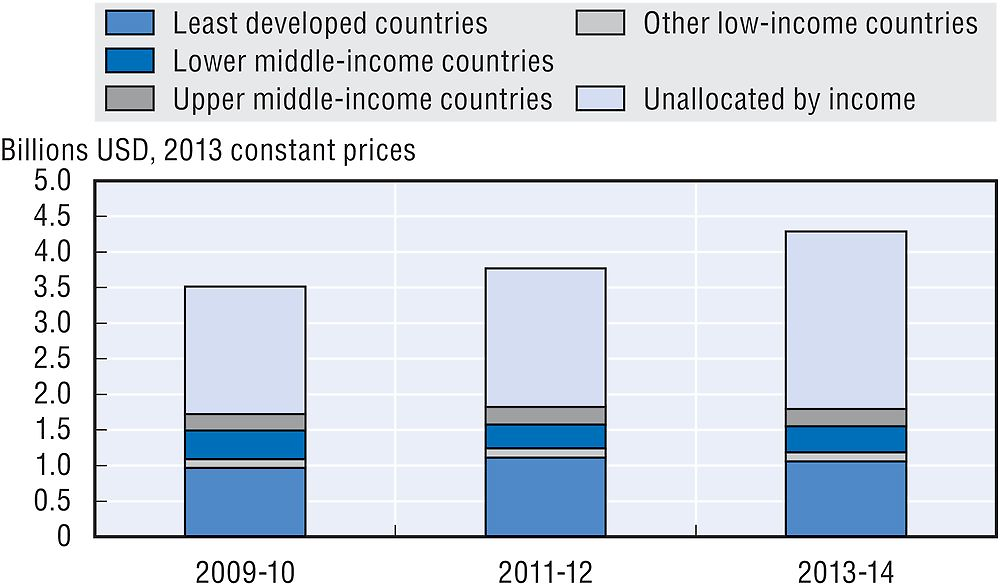
In 2014, 34.6% of bilateral ODA was allocated to social infrastructure and services, for a total of USD 1.5 billion, with a strong focus on support to government and civil society (USD 1 billion). Humanitarian aid amounted to USD 523.4 million.

USD 2.4 billion of bilateral ODA supported gender equality in 2014. Gender equality has been solidly integrated into Sweden’s projects and programmes (OECD, 2014) as a cross-cutting thematic priority. In 2014, 83.9% of Swedish bilateral sector-allocable aid had gender equality and women’s empowerment as a principal or significant objective (up from 81.8% in 2013), compared with the DAC country average of 34.7%. Sweden’s aid has an important gender focus in all sectors. Sweden has also been striving to promote gender mainstreaming in its multilateral partners’ activities and in global fora. In addition, Sweden’s government has adopted a new Feminist Foreign Policy approach, for which development co-operation is a key channel of delivery.
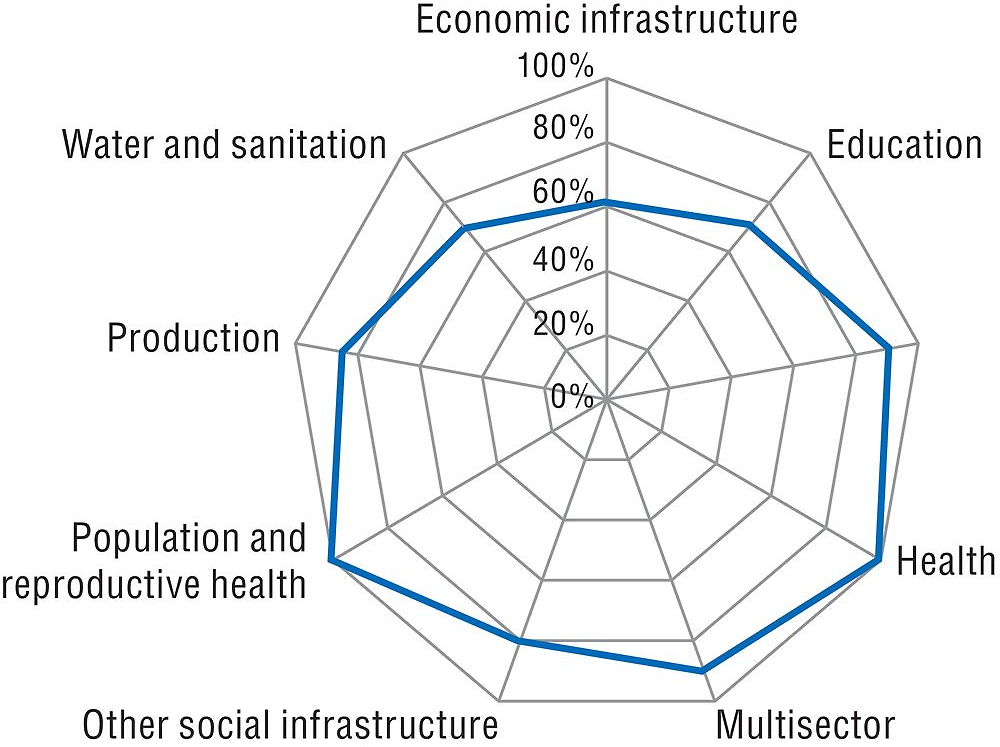
USD 1.2 billion of bilateral ODA supported the environment in 2014. Sweden integrates the environment into its programmes and projects. In 2014, 42.6% of its bilateral allocable aid supported the environment and 28.7% (USD 834.1 million) focused on climate change, compared with the respective DAC country averages of 32.2% and 23.9%.
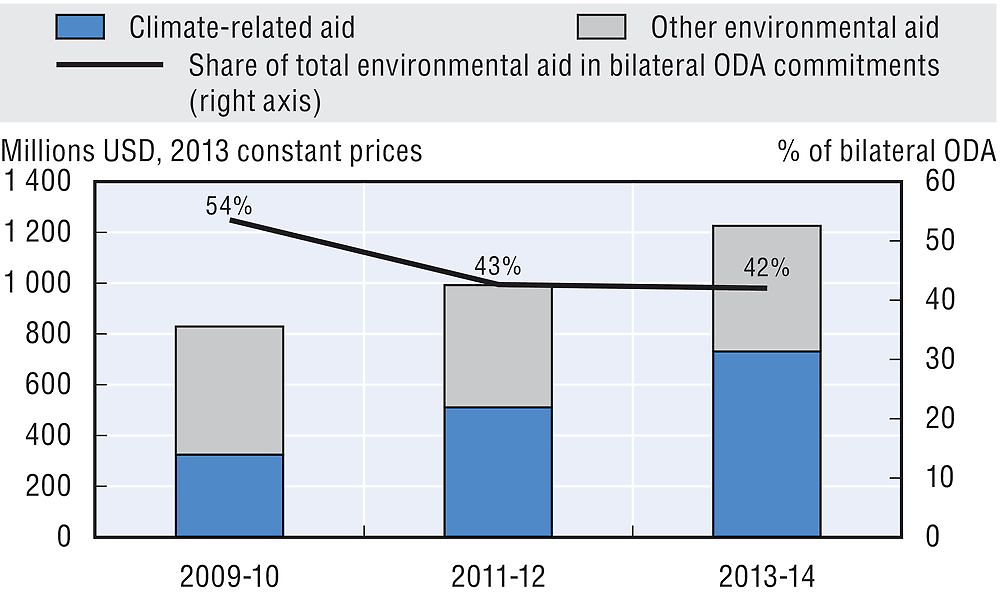
Note to reader: Annex B provides “Methodological notes on definitions and measurement for the Profiles of Development Assistance Committee members”.
Reference
OECD (2014), OECD Development Co-operation Peer Reviews: Sweden 2013, OECD Development Co-operation Peer Reviews, OECD Publishing, Paris, https://doi.org/10.1787/9789264196254-en.
